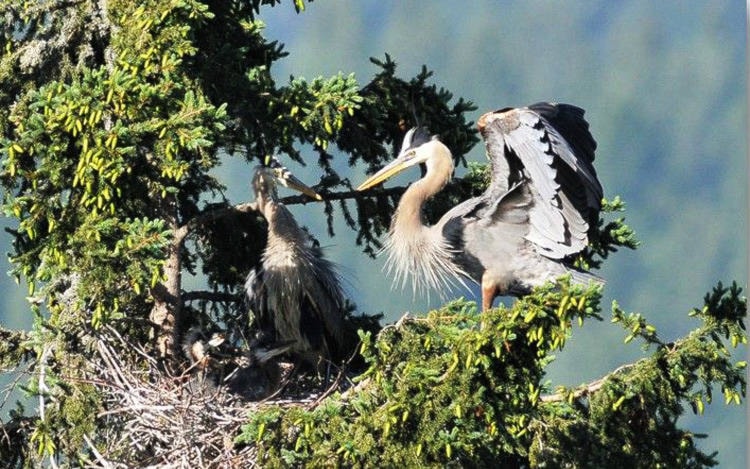The Kootenay Conservation Program is advocating for strong stewardship for the Great Blue Herons in the Kootenays, a population in decline.
According to Nicole Trigg of the KCP there are two heron subspecies in B.C. and both are provincially blue-listed because of habitat loss and disturbance in prime breeding and wintering areas.
Herons breed within a kilometre of slow-moving rivers, lakes and wetlands with rich food sources, often in colonies (known as heronries or rookeries), but occasionally as single pairs, Trigg explained. Herons need big trees to support the stick nests they build, and older deciduous and coniferous stands buffered from disturbance are preferred. Herons are sensitive, and human activity and Bald Eagle harassment and predation result in nest abandonment and/or low productivity.
Trigg says Kootenay-based biologist Marlene Machmer of Pandion Ecological Research has been studying Great Blue Herons in the Columbia Basin since 2002 and has witnessed a dramatic decline in the numbers of active and successful nests.
“By 2017, numbers of active heron nests were down to less than half of the 354 nests I counted back in 2002,” said Machmer. “Many areas with historical breeding were no longer active, and average colony size in active heronries plunged to single digits for the first time ever.”
Machmer’s focus has been on Great Blue Heron breeding and overwintering habitat in the Columbia Basin, where reservoir flooding, water level regulation, forest harvesting, habitat clearing for development and recreational activities have contributed to degradation and disturbance in key wetland and riparian habitats for herons. Ironically, even in areas set aside for conservation, herons fall victim to raids on their nests by American Crows, Common Ravens and increasing numbers of Bald Eagles, or to nest site competition with Double-Crested Cormorants, all of which are impacting their reproductive success.
Machmer focused her research in 2020 on four areas: the Columbia Wetlands Management Area, the Wycliffe Wildlife Corridor, the Creston Valley Wildlife Management Area, and the Bonanza Biodiversity Corridor in the Slocan Valley.
As part of the 2020 survey, 18 heron breeding sites were surveyed, of which 11 heron breeding sites (with 181 nests) were confirmed occupied. Seven of these (with 161 active nests) overlapped with the Kootenay Connect focal areas (i.e., two in the Creston Valley, four in the Columbia Wetlands, one in the Wycliffe Corridor). Considering just these areas, one of seven (14.3%) sites and 66 of 161 nests (41%) failed to produce young. Nest failures were related to eagle and corvid harassment and predation, coupled with nest site competition from cormorants and disturbance due to nearby human activity.
“Herons are sensitive indicators of intact freshwater ecosystems,” Machmer said. “Their population declines are very concerning and underscore the need for more conservation and stewardship directed at this provincially blue-listed sub-species.”
One objective of Kootenay Connect is to conserve key habitats of listed species. An active heron breeding area located on Crown land overlooking the Columbia Wetlands Management Area south of Nicholson was proposed as a provincial Wildlife Habitat Areas (WHA), which would limit most activities that could negatively impact this critical habitat. This site has been re-occupied for many years with 14 active heron nests in 2020, surrounded by undisturbed older forest and pocket wetlands used by a range of species.
“Herons are being progressively squeezed out of traditional breeding and overwintering areas, due to the shrinking land base of suitable habitat, coupled with increasing human encroachment and development,” Machmer said. “People can do their part by giving herons a wide berth, being vigilant, and promptly reporting disturbance around nesting and roosting sites.”
ALSO READ: Species at Risk get a boost in the Kootenays
READ: Feds fund $2M for habitat conservation in the Kootenays
carolyn.grant@kimberleybulletin.com
Like us on Facebook and follow us on Twitter
